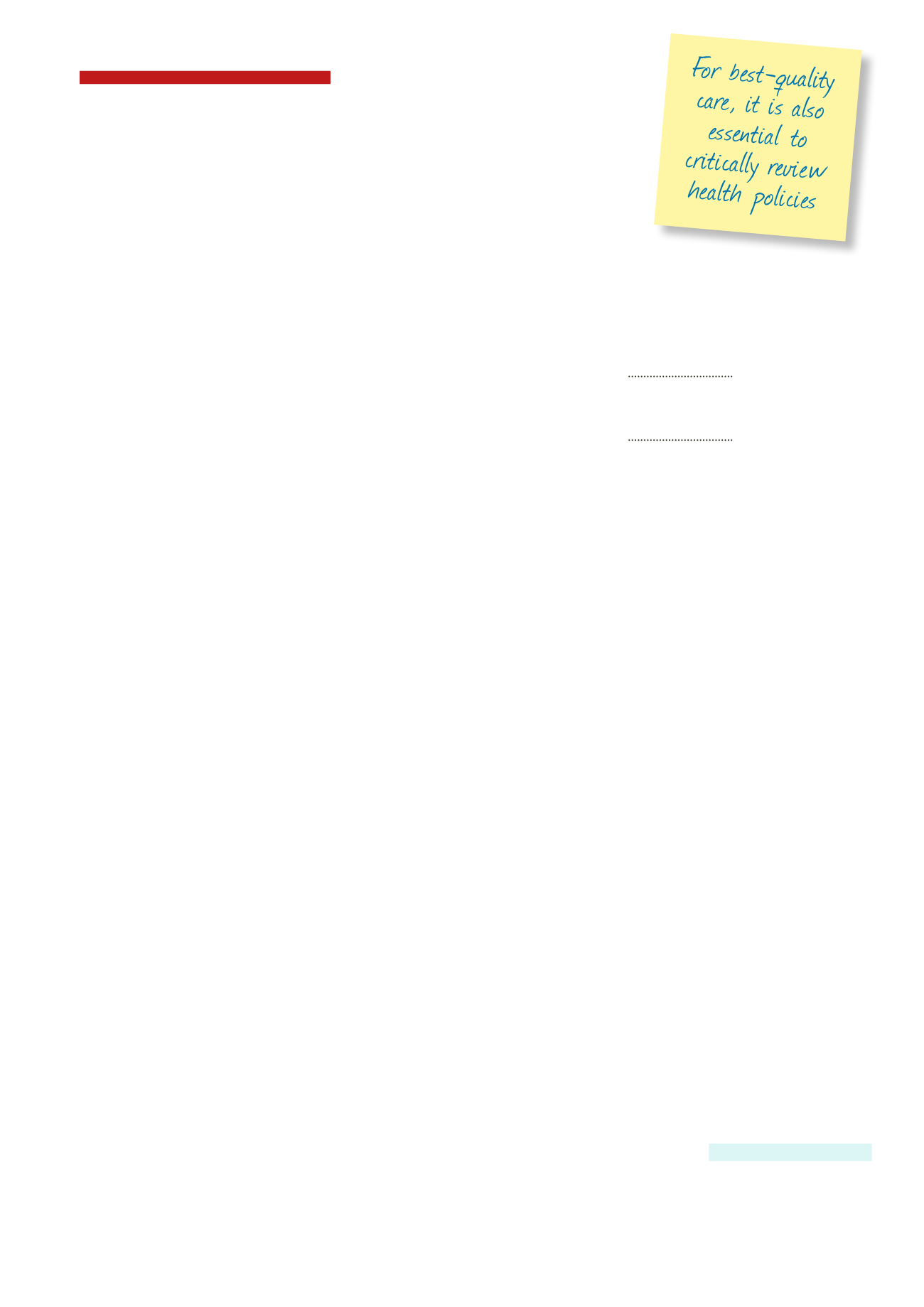
P
age
12
•Prescrire International Special Edition 2015/Volume 24 N°158
A
Outlook
Translated from
Rev Prescrire
October 2014; 34 (372): 765
Dare to refuse the exorbitant
price of Sovaldi°!
T
he price charged by Gilead for its
drug Sovaldi° (
sofosbuvir
), one of
the new antiviral agents for the
treatment of hepatitis C, caused an out-
cry in several countries, including the
United States where a 12-week course
of treatment costs 84 000 dollars per
patient (1).
Old tricks.
This exorbitant price bears
no relation to the production costs,
which a university team has estimated at
about a hundred dollars per patient (2).
Nor does it reflect the company’s R
&
D
costs: a French specialist has pointed
out that public-sector research has been
crucial for the development of HCV anti-
virals (3). What’s more, phase 3 trials of
sofosbuvir
are not particularly convincing:
they represent only the bare minimum
required to obtain marketing author-
isation. There are no trials specifically
designed to determine the harm-benefit
balance of
sofosbuvir
in fragile patients
with liver cirrhosis, for example.
A commonly used argument is that
such a high price is based on cost-
effectiveness analysis. This is simplistic,
especially given the uncertainties about
the drug’s harm-benefit balance in the
long term. According to this argument,
the antiviral efficacy of
sofosbuvir
will
reduce the costs associated with stan-
dard treatment for hepatitis C, as well
as hospitalisation and liver transplanta-
tion (4,5).
In short, Gilead is using a classic
marketing ploy: highlighting the good
news (virological efficacy) while min-
imising potential drawbacks (clinical
trials of
sofosbuvir
available in 2014
were not designed to clearly identify
adverse effects). The company has cap-
tured media attention, in this case with
a request for a sky-high price. This start-
ing price allows the company to obtain
prices that may be lower than requested,
but that are still exorbitant, in its negoti-
ations with health authorities (
a
).
These types of market manipulation
are well-known (6).
Speculation.
The company that devel-
oped
sofosbuvir
(7) was called Pharm-
asset, a name that could hardly be more
explicit: the goal was simply to create
market value by selling promising can-
didate drugs to major pharmaceutical
companies (8).
Pharmasset shares were worth 9 dollars
each in 2006 (9). In 2011, Gilead acquired
Pharmasset at a price 89% above its last
market valuation, paying 137 USD per
share at a total cost of 11 billion USD (7).
Stock analysts estimated that annual sales
of Sovaldi° would have to reach at least
4 billion USD for the transaction to be
profitable (7).
By cashing in their stock options,
Pharmasset employees became overnight
multimillionaires (10), while the Gilead
CEO became a billionaire when the com-
pany’s market value soared (11).
Resisting manipulation.
A stock
analyst hailed Gilead’s “brilliant trans-
action” (11), overlooking the fact that, in
reality, this financial coup for investors
represented blatant exploitation of the
healthcare sector, which is largely sub-
sidised by taxpayers. Runaway market
prices of this sort threaten the survival of
public and non-profit health insurance
systems.
The iconic example of
sofosbuvir
calls
for an unprecedented public reaction.
Politicians, healthcare professionals and
patients alike must refuse to tolerate
these manipulations, which threaten to
undermine universal access to health-
care.
Some patient organisations have gone
so far as to demand that the French
government authorise generic manu-
facturers to produce
sofosbuvir
at a rea-
sonable price through a compulsory
licence, despite Gilead’s patent rights
(12). Faced with these exorbitant prices,
which stemmainly from financial specu-
lation, governments must dare to adopt
a firm stance, so that drug companies
and financial speculators will not carry
on using the market for medicines as a
money machine pumping out high rates
of return, to the detriment of patients
and of society.
Prescrire
a-
Gilead has announced lower prices outside the United
States, especially in developing countries (refs 13,14), yet
the total expenditure remains exorbitant (ref. 15).
Selected references from Prescrire’s literature
search.
1-
Staton T “Politicians add fuel to the firestorm
over Gilead’s hep C drug pricing” 24 March 2014.
accessed 23 June 2014:
2 pages.
2-
Hill A et al. “Minimum costs to produce hepa-
titis C direct acting antivirals for access programs
in developing countries”
Clin Infect Dis
2014;
58
(7): 928-936.
3-
“3 questions posées à Jean-Michel Pawlotsky”
3 June 2014.
accessed 24 June 2014:
1 page.
4-
Hirschler B et al. “Britain’s cost agency not
ready to back Gilead Doctors hepatitis C drug”
16 June 2014.
23 June
2014: 1 page.
5-
Palmer E “Germany says it is unclear whether
Gilead’s Sovaldi prevents liver cancer” 2 May
2014.
accessed 24 June
2014: 2 pages.
6-
PrescrireRédaction “Petit traité demanipulation
à l’usage des honnêtes gens”
Rev Prescrire
2008;
28
(300): 789.
7-
Pollack A and de la Merced MJ “Gilead to buy
Pharmasset for $11 billion” 21 November 2011.
Website dealbook.nytimes.com accessed 23 June
2014: 4 pages.
8-
Berkrot B “Gilead could have had Pharmas-
set cheap: founder” 22 November 2011. www.
reuters.com accessed 9 July 2014: 1 page.
9-
Middendorf I “Pharmasset (VRUS)” undated
(prior to 2012).
accessed
23 June 2014: 2 pages.
10-
ThurmS “Big paydays for Pharmasset employ-
ees from Gilead deal” 22 novembre 2011. blogs.
wsj.com accessed 23 June 2014: 2 pages.
11-
Langreth R “Gilead CEO becomes billionaire
on $84,000 hepatitis drug” 3 March 2014. www.
bloomberg.com accessed 24 June 2014: 3 pages.
12-
Bonjour M et al. “Hépatite C: de l’injuste prix
à l’exclusion des soins” 28 July 2014. www.
soshepatites.org accessed 29 July: 2 pages.
13-
Heavey S “US drug industry group defends
price of Gileadhepatitis drug” 10April 2014. www.
reuters.com accessed 23 June 2014: 1 page.
14-
Beasley D and Hirschler B “Doctors welcome
hepatitis C drug rivals, Gilead still leads” 11 April
2014.
accessed 23 June 2014:
1 page.
15-
Delfraissy JF “Éradiquer l’hépatite C: mais à
quel prix?” 3 June 2014.
accessed
24 June 2014: 2 pages.
Prescrire Int • November 2014


